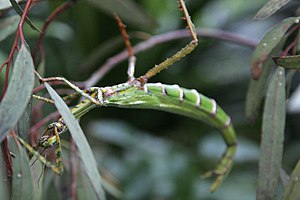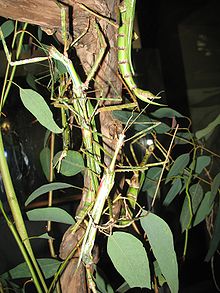Australian giant stick insect
| Australian giant stick insect | ||||||||||||
|---|---|---|---|---|---|---|---|---|---|---|---|---|

Australian giant stick insect ( Eurycnema goliath ), female |
||||||||||||
| Systematics | ||||||||||||
|
||||||||||||
| Scientific name | ||||||||||||
| Eurycnema goliath | ||||||||||||
| ( Gray, GR , 1834) |
The Australian giant stick insect ( Eurycnema goliath ), which is sometimes referred to as the great splendor stick insect , is one of the most colorful representatives of the ghost insects . In the English-speaking world, it is known as Goliath Stick Insect and Regal Stick Insect .
features
The basic color of adults is green. The head, front ( pronotum ) and middle chest ( mesonotum ) are yellow with conspicuous, turquoise longitudinal stripes. The underside of the middle and rear chest ( metanotum ) as well as the thighs and rails of the front and middle legs are yellow with green transverse bands. The thorny hind legs and the joint areas of the front and middle legs and their tarsi are mottled orange-brown. The rear edges of the abdominal segments are red-brown and, especially in females, have a white area in front of this red-brown area. This drawing shows a noticeable horizontal stripes in both sexes. Both the short tegmina and the fully developed hind wings are predominantly green and in the males sometimes marked with white sections running lengthways to the body. The underside of the tegmina and the costal fields of the hind wings are bright red. The subgenital plate is elongated in the female. Males grow up to 15 centimeters, females about 22 centimeters long. Only after the last moult , i.e. as adults , do the animals show the coloration described. As nymphs , they are beige to brown in color.
Occurrence and way of life
The home of Eurycnema goliath is, as its German name suggests, Australia and here more the east and middle of the continent. Their diet consists exclusively of eucalyptus and acacia . When disturbed, they rustle and unfold their red-colored wings underneath and defend themselves with their thorny hind legs. The males often just fly away.
Reproduction
During their eight-month life, the females hurl up to 300 eggs that are about five millimeters long, four millimeters wide and 30 milligrams heavy. After 7 to 15 months, the nymphs hatch, which are adult after at least five months.
Systematics
The Australian giant stick insect was described by George Robert Gray under the name Phasma (Diura) goliath in 1834 . A female was deposited in Melbourne as a hololectotype . After the species was placed one after the other in the partially invalid genera Cyphocrana , Acrophylla and Cyphocrania in the following years , William Forsell Kirby finally assigned it to the genus Eurycnema in 1904 , which was mentioned as a subgenus of Cyphocrana by Jean Guillaume Audinet Serville in 1838 . Further synonyms for the species are:
- Phasma (Diura) acheron Gray, GR , 1834
- Eurycnema magnifica Kirby , 1904
- Clemacantha regale Rainbow , 1897
- Eurycnema viridissima Kirby , 1904
Terrariums
Although the species is in great demand because of its color and size, it presents the terrarium keeper with the difficult task of regularly procuring suitable food, namely eucalyptus or acacia. Only adult animals can be fed on the leaves of hazel or oak in summer . In the terrarium , which should not be a closed glass container, but a large, air-permeable gauze cage (caterpillar box), temperatures above 25 ° C are required. Since neither the forage plants nor the animals themselves should be sprayed and the humidity must not be too high, regular spraying of the soil is sufficient. Only the newly hatched nymphs need a slightly higher humidity.
The Australian giant stick insect was introduced several times in the 1970s, including from Melbourne Zoo . The Phasmid Study Group has it under PSG number 14.
Web links
Individual evidence
- ↑ a b c Sascha Eilmus on austria-aqua.net about E. goliath
- ↑ Oliver Zompro : Basic knowledge of pasmids. Biology - keeping - breeding . Sungaya Verlag, Berlin 2012, ISBN 978-3-943592-00-9 , p. 53.
- ^ A b Paul D. Brock : Phasmida Species File Online . Version 2.1 / 3.5. (accessed on June 14, 2009)
- ↑ a b c Christoph Seiler, Sven Bradler, Rainer Koch: Phasmids - care and breeding of ghosts, stick insects and walking leaves in the terrarium . bede, Ruhmannsfelden 2000, ISBN 3-933646-89-8 .
- ↑ Phasmatodea page by Oskar V. Conle and Frank H. Hennemann
- ↑ PSG Culture List on the Phasmid Study Group website .
